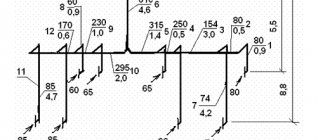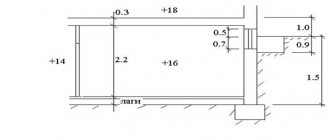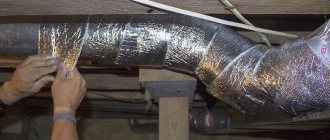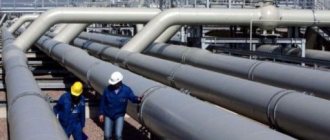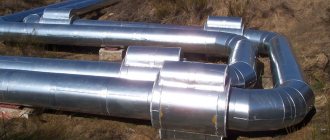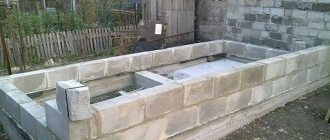Those who have once had to deal with freezing pipes know what a scourge this is. And for the rest of their lives they remembered an important rule - it is necessary to insulate the water supply systems in advance! Of course, it’s better to learn from other people’s mistakes.
That is why in our article we will consider such an issue as the correct calculation of thermal insulation of pipelines.
Work on the construction and insulation of the pipeline
Calculation methods
In order to decide on the choice of suitable insulation, it is necessary to calculate the optimal thickness and density of the material for a particular case. This calculation allows not only to reduce heat loss, but also to reduce the temperature of the pipes, for the purpose of their safe use.
What factors need to be taken into account when calculating?
- Temperature of the insulated surface;
- Temperature changes in the environment;
- The presence of mechanical influences (for example, vibration, etc.);
- Permissible loads on pipes;
- Loads from overlying soil and vehicles;
- The thermal conductivity coefficient of the selected insulation;
- Resistance of the insulating material to deformation.
Pipeline insulation with mineral wool
Important! SNiP 41-03-2003 clearly states what the characteristics of insulation materials should be for various types of pipelines and operating conditions. For example, for insulated pipes with temperatures below 12º C, according to SNiP requirements, the thermal insulation must include a vapor barrier layer.
Now we will look at the calculation of pipeline thermal insulation - two proven methods, each of which is convenient and reliable in its own way.
Engineering calculation using formulas
The optimal thickness of the insulation layer is found by technical and economic calculation: the thickness of the material is determined based on its temperature resistance - at least 0.86 (ºC m²/W) for pipes with a diameter less than or equal to 25 mm, and 1.22 (ºC m²/W ) for pipes with a diameter greater than 25 mm.
The information below will be useful when carrying out engineering calculations of thermal insulation for various pipelines. As an example, we will calculate the required insulation thickness for the exhaust manifold of a high-performance diesel engine.
The total temperature resistance of the insulating structure for a cylindrical pipe is determined by the following formula:
Formula for finding the temperature resistance of insulation
- diz – outer diameter of the insulation for the pipe;
- dн – outer diameter of the pipe;
- from is the thermal conductivity coefficient of the insulating material;
- c – heat transfer coefficient from the insulation to the air.
Linear heat flux density:
Finding the linear heat flux density
- tн – temperature of the outer wall of the pipe;
- tiz is the surface temperature of the insulating layer.
Temperature of the inner wall of the pipe insulation:
Finding the temperature of the inner wall of the pipeline insulation
- dв – internal diameter of the pipe;
- g – heat transfer coefficient from the gas to the wall;
- t is the thermal conductivity coefficient of the material from which the pipe is made.
Formula for finding heat balance:
Finding Thermal Balance
With its help, the required outer diameter of the insulation for the pipe (diz) is determined. Then the calculation of the thickness of the thermal insulation of pipelines is calculated using the formula:
Finding the thickness of insulation
Calculation example: the task was set to calculate the thermal insulation for a high-performance diesel pipeline.
The following values are available:
- outer diameter of the pipeline – 0.6 m;
- its internal diameter is 0.594 m;
- temperature of the outer wall of the pipeline – 725 K;
- temperature of the outer surface of the insulation – 333 K;
- thermal conductivity coefficient of insulation is 0.11 W/(m K).
Substituting all the values into the formulas given above, we obtain the required insulation thickness for the pipeline - at least 0.1 m.
Advice! If you think that you will not be able to use the above formulas correctly, then contact our engineers for help. They will make a professional calculation, which will allow you to be sure that the thermal insulation will be of really high quality. The price for specialist services is quite reasonable and accessible to everyone.
If you nevertheless decide to do all the work yourself, then remember that the calculation of the thickness of the insulation for the pipeline should be carried out under specific conditions - from the insulation material to seasonal temperature changes outside and air humidity. By the way, humidity significantly accelerates heat transfer and reduces the effectiveness of some insulation materials (for example, mineral wool).
Online calculator – an indispensable assistant in thermal insulation calculations
In addition to the services of a qualified engineer, there is the option of using an online assistant. The calculator for calculating thermal insulation of pipelines is an absolutely free program that does not require installation or any payment. With its help, you can do it yourself and make an accurate calculation in a matter of minutes.
This is what the online assistant actually looks like
Using the calculator is quite simple.
First, you are asked to choose one of four tasks:
- insulation of the pipeline in order to ensure the specified temperature on the insulation surface;
- insulation of the pipeline in order to prevent freezing of the liquid contained in it;
- insulation of the pipeline to prevent moisture condensation on the insulation surface;
- insulation of the pipeline of a water heating network of two-pipe underground channel laying.
Next, you will be asked to enter some data necessary for the calculation:
- insulation material (in the proposed list you will certainly find the insulation you prefer);
- outer diameter of the pipeline (mm);
- temperature of the insulated surface (ºC);
- how long does it take before water freezes in a state of inertia;
- the presence of a protective coating (metallic or non-metallic);
- average temperature of the coolant (water, etc.).
Enter all the necessary parameters
Now all that remains is to press the “calculate” button and get the most accurate result.
The result will appear in approximately this form:
Choosing insulation
The main reason for pipeline freezing is insufficient energy circulation speed. In this case, at sub-zero air temperatures, the process of crystallization of the liquid may begin. So high-quality thermal insulation of pipes is vital.
Attention! This is especially true for those pipelines that operate intermittently (for example, a water heating system in a country house). Therefore, in order to avoid having to defrost and restore the system, you need to take care of its thermal insulation in advance.
Fortunately, our generation is incredibly lucky. In the recent past, insulation of pipelines was carried out using only one technology, since there was only one insulation - glass wool. Modern manufacturers of thermal insulation materials simply offer the widest selection of pipe insulation materials, differing in composition, characteristics and method of application.
It is not entirely correct to compare them with each other, much less to say that one of them is the best. So let's just look at the types of pipe insulation materials.
Database
The program has its own database of insulating materials. This database is open and flexible in its structure - it allows you to view data on materials and edit them using a convenient database editor. The database includes both basic and auxiliary materials, as well as their properties, main manufacturers and the sizes they produce. We are open to cooperation with all manufacturers of materials (supplying high-quality and certified products) to replenish the database with their materials.
Pipeline insulation options
Finally, we will consider three effective methods of thermal insulation of pipelines.
Perhaps one of them will appeal to you:
- Insulation using a heating cable . In addition to traditional isolation methods, there is also an alternative method. Using the cable is very convenient and productive, considering that you only need to protect the pipeline from freezing for six months. In the case of heating pipes with cables, there is a significant saving of effort and money that would have to be spent on earthworks, insulation material and other issues. The operating instructions allow for the cable to be located both outside and inside the pipes.
Additional thermal insulation with heating cable
- Air insulation . The mistake of modern thermal insulation systems is this: they often do not take into account the fact that soil freezing occurs according to the “top to bottom” principle. The freezing process is met by a flow of heat emanating from the depths of the earth. But since insulation is carried out on all sides of the pipeline, it turns out that I also insulate it from rising heat. Therefore, it is more rational to install insulation in the form of an umbrella over the pipes. In this case, the air gap will act as a kind of heat accumulator.
- "Pipe in pipe" . Here, more pipes are laid in polypropylene pipes. What advantages does this method have? First of all, the advantage is that the pipeline can be heated in any case. In addition, heating is possible using a device for suctioning warm air. And in emergency situations, you can quickly extend the emergency hose, thereby preventing all negative aspects.
Insulation based on the “pipe-in-pipe” principle
Conclusion
So we discussed all the most important points regarding the insulation of pipelines. Regardless of what material and method you choose for this purpose, before you begin installing thermal insulation, it is advisable to calculate the amount of insulation required and its cost.
This way you will save effort and financial costs in the future. Good luck to all builders of your warm present and future! In the video presented in this article you will find additional information on this topic.
The thickness of the thermal insulation layer is calculated by the formula:
where: d is the outer diameter of the heat-insulated pipeline, mm;
B is the ratio of the outer diameter of the heat-insulating layer to the outer diameter of the pipeline, mm.
The value of B can be calculated from the following equation:
where: λk - thermal conductivity of the heat-insulating layer, W / (m × ºС) - taken according to the manufacturer's data; rtot - heat transfer resistance 1 l.m. thermal insulation structure / W, determined based on the normalized linear heat flux density according to the formula:
tw—average coolant temperature, ºС; tв — ambient temperature, ºС; qе - normalized linear heat flux density, W/m, taken according to Table 20; K1 is a coefficient that takes into account the change in the cost of heat and thermal insulation structure depending on the construction area and the method of laying the pipeline, adopted according to Table 18; re - thermal resistance of the pipeline wall, W / (m × ºС) - is not taken into account due to its small value for steel pipelines; αe is the heat transfer coefficient from the outer surface of the insulation, W / (m 2 × ºС), taken according to table 19.
Briefly about the main thing
An online pipeline insulation calculator allows you to quickly calculate the thickness and volume of heat-insulating material. Thanks to the use of technology, you will save time, optimize costs and protect yourself from errors that are common in manual calculations with their cumbersome formulas.
Calculations may differ slightly depending on the task being set. For example, protection against heat loss, condensation or freezing of pipe contents. Accordingly, the data required to enter may vary.
Characteristics of network laying and standard calculation methods
Carrying out calculations to determine the thickness of the heat-insulating layer of cylindrical surfaces is a rather labor-intensive and complex process. If you are not ready to entrust it to specialists, you should be careful and patient to get the right result. The most common way to calculate the thermal insulation of pipes is based on standardized heat loss indicators. The fact is that SNiP establishes the values of heat loss by pipelines of different diameters and with different methods of laying them:
Pipe insulation diagram.
- open method on the street;
- open in a room or tunnel;
- channelless method;
- in impassable channels.
The essence of the calculation is to select the heat-insulating material and its thickness in such a way that the amount of heat loss does not exceed the values prescribed in SNiP. The calculation methodology is also regulated by regulatory documents, namely the relevant Code of Rules. The latter offers a slightly more simplified methodology than most existing technical reference books. Simplifications include the following points:
- Heat losses when the pipe walls are heated by the medium transported in it are negligible compared to the losses that are lost in the layer of external insulation. For this reason, they can be ignored.
- The vast majority of all process and network pipelines are made of steel; its heat transfer resistance is extremely low. Especially when compared with the same insulation indicator. Therefore, it is recommended not to take into account the heat transfer resistance of the metal pipe wall.
Configuration
Description of options
The following modules are supplied with the program:
- STARS library
Designed for calculating the thermophysical properties of transported products for those calculation criteria for which they are necessary
- Based on the data of SP 131.13330.2018 “SNiP 23-01-99* Construction climatology” allows you to determine the climatic parameters of the settlement where the object is located
- Which declines the texts of the names of materials and isolated objects for output documents
Methodology for calculating a single-layer thermal insulation structure
The basic formula for calculating the thermal insulation of pipelines shows the relationship between the amount of heat flow from an existing pipe covered with a layer of insulation and its thickness. The formula applies if the pipe diameter is less than 2 m:
Formula for calculating thermal insulation of pipes.
- λ — thermal conductivity coefficient of insulation, W/(m ⁰C);
- K is the dimensionless coefficient of additional heat loss through fasteners or supports, some values of K can be taken from Table 1;
- tt is the temperature in degrees of the transported medium or coolant;
- to—outside air temperature, ⁰C;
- qL—heat flow value, W/m2;
- Rн - heat transfer resistance on the outer surface of the insulation, (m 2 ⁰C) / W.
| Pipe laying conditions | K coefficient value |
| Steel pipelines are open along the street, through channels, tunnels, open indoors on sliding supports with a nominal diameter of up to 150 mm. | 1.2 |
| Steel pipelines are open along the street, through channels, tunnels, open indoors on sliding supports with a nominal diameter of 150 mm or more. | 1.15 |
| Steel pipelines are open along the street, through canals, tunnels, and open indoors on suspended supports. | 1.05 |
| Non-metallic pipelines laid on suspended or sliding supports. | 1.7 |
| Channelless installation method. | 1.15 |
The thermal conductivity value of the insulation λ is a reference value, depending on the selected thermal insulation material. It is recommended to take the temperature of the transported medium tt as the average throughout the year, and the temperature of the outside air tto as the average annual temperature. If the insulated pipeline runs indoors, then the ambient temperature is set by the technical specifications for the design, and in its absence it is taken equal to +20°C. The indicator of heat transfer resistance on the surface of a heat-insulating structure Rн for outdoor installation conditions can be taken from Table 2.
| Rн,(m 2 ⁰C) /W | DN32 | DN40 | DN50 | DN100 | DN125 | DN150 | DN200 | DN250 | DN300 | DN350 | DN400 | DN500 | DN600 | DN700 |
| tt = 100 ⁰C | 0.12 | 0.10 | 0.09 | 0.07 | 0.05 | 0.05 | 0.04 | 0.03 | 0.03 | 0.03 | 0.02 | 0.02 | 0.017 | 0.015 |
| tt = 300 ⁰C | 0.09 | 0.07 | 0.06 | 0.05 | 0.04 | 0.04 | 0.03 | 0.03 | 0.02 | 0.02 | 0.02 | 0.02 | 0.015 | 0.013 |
| tt = 500 ⁰C | 0.07 | 0.05 | 0.04 | 0.04 | 0.03 | 0.03 | 0.03 | 0.02 | 0.02 | 0.02 | 0.02 | 0.016 | 0.014 | 0.012 |
Note: the value of Rн at intermediate values of coolant temperature is calculated by interpolation. If the temperature is below 100 ⁰C, the value of Rн is taken as for 100 ⁰C.
Indicator B should be calculated separately:
Table of heat losses for different pipe thicknesses and thermal insulation.
- diz - outer diameter of the heat-insulating structure, m;
- dtr — outer diameter of the protected pipe, m;
- δ—thickness of the thermal insulation structure, m.
Calculation of the thickness of pipeline insulation begins with determining the indicator ln B, substituting into the formula the values of the outer diameters of the pipe and thermal insulation structure, as well as the thickness of the layer, after which the parameter ln B is found using the table of natural logarithms. It is substituted into the main formula along with the indicator of the normalized heat flow qL and make a calculation. That is, the thickness of the pipeline insulation must be such that the right and left sides of the equation become identical. This thickness value should be taken for further development.
The considered calculation method applied to pipelines with a diameter of less than 2 m. For pipes of larger diameter, the calculation of insulation is somewhat simpler and is carried out both for a flat surface and using a different formula:
- δ—thickness of the thermal insulation structure, m;
- qF is the value of the normalized heat flow, W/m2;
- other parameters are the same as in the calculation formula for a cylindrical surface.
Calculation of pipeline insulation materials
It is not difficult to carry out insulation calculations for pipelines; for convenience, it is recommended to use special calculators.
There are a number of actions that allow you to preliminarily determine the volume of materials. Before starting calculations, you should immediately decide what type of insulation will be used. Insulators differ not only in appearance, but also in installation conditions and properties.
Painting agents can be used to insulate pipelines.
The quality of the materials is high, the layer is thin but durable, fully performing all functions. The calculation is done as follows:
The formula for calculating the area of the cylinder is S=2πr(h+r), where r is the radius of the base of the pipe, h is the pipe length parameter, π is a constant, the approximate value for this case is 3.14. The resulting value is the coloring area. Next, according to the manufacturer’s instructions, determine the material consumption.
Scheme for calculating thermal insulation for a pipe.
When using conventional insulating materials, calculations are much simpler. It is necessary to determine the volume for the inside and outside of the pipe. To do this, use the formula V=πr2h, where:
- V – pipeline volume; r – radius value (external or internal); h – pipe length; π is equal to 3.14.
The value of the internal and external radius is calculated separately, the resulting difference will be equal to the volume of the entire pipeline insulation material. Wrapping is an option for external insulation. In this case, the calculation is performed similarly using the first formula indicated, but it is necessary to take into account the thickness of the material, since it affects the quantity.
Methodology for calculating a multilayer thermal insulation structure
Copper and steel pipe insulation chart.
Some transported media have a fairly high temperature, which is transferred to the outer surface of the metal pipe almost unchanged. When choosing a material for thermal insulation of such an object, they are faced with the following problem: not every material is able to withstand high temperatures, for example, 500-600⁰C. Products capable of contact with such a hot surface, in turn, do not have sufficiently high thermal insulation properties, and the thickness of the structure will be unacceptably large. The solution is to use two layers of different materials, each of which performs its own function: the first layer protects the hot surface from the second, which protects the pipeline from the effects of low outside air temperatures. The main condition for such thermal protection is that the temperature at the boundary of the layers t1,2 be acceptable for the material of the outer insulating coating.
Interface
Program dialog box
Material Database Editor Window
“Conditions of applicability of materials” window for setting up rules for selecting materials
Working window of the built-in module “Construction Climatology”, corresponding to SP 131.13330.2018 “SNiP 23-01-99* Construction Climatology”
Automatically generated material applicability diagram
Method for determining by a given value the reduction in coolant temperature
Materials for thermal insulation of pipes according to SNiP.
A problem of this kind is often posed when the transported medium must reach its final destination through pipelines at a certain temperature. Therefore, the determination of the insulation thickness is required to be made by a given temperature reduction value. For example, from point A the coolant leaves through a pipe with a temperature of 150⁰C, and to point B it must be delivered with a temperature of at least 100⁰C, the difference should not exceed 50⁰C. For this calculation, the length l of the pipeline in meters is entered into the formulas.
First, you should find the total heat transfer resistance Rп of the entire thermal insulation of the object. The parameter is calculated in two different ways depending on the following condition:
If the value (tt.start - tо) / (tt.fin - tо) is greater than or equal to the number 2, then the value of Rп is calculated using the formula:
In the given formulas:
- K is the dimensionless coefficient of additional heat loss through fasteners or supports (Table 1);
- tt.init - initial temperature in degrees of the transported medium or coolant;
- to—ambient temperature, ⁰C;
- tt.kon is the final temperature in degrees of the transported medium;
- Rп - total thermal resistance of insulation, (m 2 ⁰C) / W
- l is the length of the pipeline route, m;
- G—consumption of transported medium, kg/h;
- C is the specific heat capacity of this medium, kJ/(kg ⁰C).
Thermal insulation of steel pipe made of basalt fiber.
Otherwise, the expression (tt.start - to) / (tt.end - to) is less than the number 2, the value of Rp is calculated as follows:
The parameter designations are the same as in the previous formula. The found value of thermal resistance Rп is substituted into the equation:
- λ — thermal conductivity coefficient of insulation, W/(m ⁰C);
- Rн - heat transfer resistance on the outer surface of the insulation, (m 2 ⁰C) / W.
Then they find the numerical value of B and calculate the insulation using the familiar formula:
In this method for calculating pipeline insulation, the ambient temperature t should be taken based on the average temperature of the coldest five-day period. Parameters K and Rn - according to tables 1 and 2 above. More detailed tables for these values are available in the regulatory documentation (SNiP 41-03-2003, Code of Rules 41-103-2000).
Online calculator to calculate the required volume of thermal insulation for pipelines
In the conditions of our country with its vast expanses, pipeline transport is the most effective means of transporting liquid products. The dimensions of the pipes reach three meters in diameter, which makes it possible to transport large volumes of products through them. Naturally, such highways require certain protection from various factors:
- corrosion of all types;
- freezing;
- physical impact of natural phenomena;
- from unauthorized intervention by unauthorized persons.
All highways, including gas and oil pipelines, not to mention water systems, are subject to insulation for operation in the temperature range of -45 + 60 degrees. Mass application of such a technological operation requires careful calculation of the need for materials for covering the surface of pipes, so that the costs for it are optimal; calculating the insulation of pipelines using various calculators is a necessity.
Method for determining the surface temperature of an insulating layer based on a given temperature
This requirement is relevant in industrial enterprises where various pipelines run inside rooms and workshops where people work. In this case, the temperature of any heated surface is normalized in accordance with labor protection rules in order to avoid burns. Calculation of the thickness of the thermal insulation structure for pipes with a diameter over 2 m is carried out in accordance with the formula:
Formula for determining the thickness of thermal insulation.
- ɑ — heat transfer coefficient, taken from reference tables, W/(m 2 ⁰C);
- tп – normalized temperature of the surface of the heat-insulating layer, ⁰C;
- other parameters are as in the previous formulas.
The thickness of the insulation on a cylindrical surface is calculated using the equation:
Designations of all parameters are as in the previous formulas. According to the algorithm, this calculation is similar to calculating the thickness of insulation based on a given heat flow. Therefore, it is then carried out in exactly the same way; the final value of the thickness of the heat-insulating layer δ is found as follows:
The proposed method has some error, although it is quite acceptable for preliminary determination of the parameters of the insulating layer. A more accurate calculation is performed by the method of successive approximations using a personal computer and specialized software.

